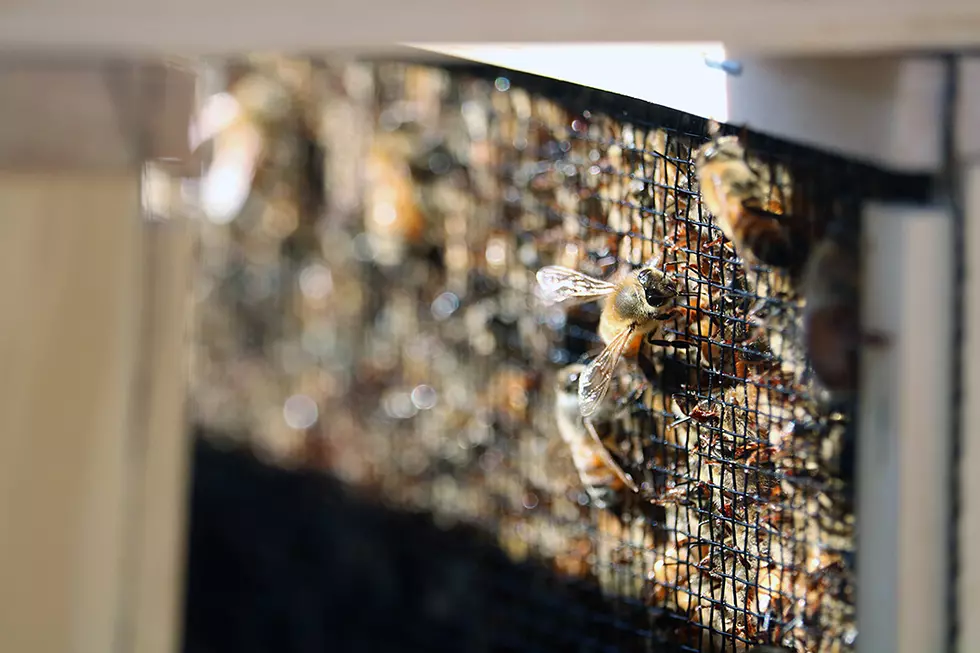
Pollinators: Western Montana beekeepers take delivery of 2.5M California honeybees
The morning chill wasn't the only thing in the air early Friday at Fort Missoula.
Several dozen “farmers” stood in line, stirring with anticipation. In the distance came the rumble of a trailer, a cloud of dust, and the drone of nearly three million bees.
Welcome to western Montana, you California pollinators.
“Typically, it'll take a few days for these colonies from California to settle in if we've got cool weather, because they're kind of sitting back saying, 'Well, it's got to get warm pretty soon,' ” said Jerry Bromenshenk. “After a few days, they'll realize it doesn't get that warm and they'll adapt. They'll have to adjust.”
Bromenshenk, a University of Montana research professor in insect behavior and king of the school's master beekeeping program, transported the spring crop of California honeybees from Polson to Missoula early Friday.
Beekeepers from across Missoula and the Bitterroot Valley arrived early with tickets in hand to take one or more packages to their respective pastures. The bees themselves are forming new colonies, having embraced their queen.
“They take the bees from multiple colonies and shake them into a box and introduce them to a queen,” said Scott Debnam, a UM graduate and manager of the school's research colonies. “None of them are related to one another and none of them are related to the mother. It's a marvel they form a colony, but they do.”
The bees arrived in boxes, or packages, stacked two rows deep. Each box contains a queen and 15,000 bees, along with a supply of food. The worker bees gathered tightly around the queen, growing active as the sun hit the trailer.
Once they get home and shake off the Montana chill, Bromenshenk said, they'll get to work laying eggs, exploring and pollinating spring flowers. The crop of honey to follow will be sweet and locally sourced.
“As soon as these get in the hive, that queen will start laying and they'll start doing that, and in 21 days we'll have new bees,” Bromenshenk said. “Twenty-one days from an egg to a young bee, then a couple weeks in the hive learning the job.”
Once they master their housekeeping skills, as Bromenshenk calls it, the young bees are free to fly the world and “visit flowers.” But inevitably, they'll grow old and tired. The entire cycle lasts just a few months.
“Summer bees, we're talking a couple months, but the winter bees go the whole winter,” he said. “Now the queen, she can live three to eight years. She'll see several generations, all her daughters.”
According to the Montana Department of Agriculture, the state is home to roughly 200 registered beekeepers. Around 90 of them are commercial and 50 are involved in migratory pollination as a primary business.
The remainder are honey producers, landowners and hobbyists, like many of those who collected their package on Friday. Bill Harlon of Victor is returning to the hobby after taking several years off.
“I had 24 hives here a few years back when we had that big die-off across the country. I lost all but one and I've slacked off until now,” said Harlon. “I plan to split the hive I have at home and pick up two more here, so I'll have four hives. I like to get out there and do it by myself and not get pestered.”
Montana is generally ranked among the top 10 honey producing states each year. Its producers harvest around 15 million pounds of honey annually, a crop worth around $31 million.
It ranks among Montana's most valuable crops and is sweetened by the long summer days and cool summer nights, along with miles of open space and plenty of flowers.
“This is my first time ever doing it, and I'm hoping they make it through the winter and reproduce for next year,” said Dorenda Berry, who purchased a single package of bees. “I believe we really need our honey bees. They're great pollinators. They're neat to see out in the flowers.”
New to the hobby, Berry admitted some nervousness, though she's been preparing for a year. She received beehive boxes for Mother's Day and is a member of the Bitterroot Bee Club.
“I'm not sure what to expect, but there's a lot of people who are great resources,” she said.
Bromenshenk and Debnam stand among them.
“The more you understand the organism, the more you can make decisions,” said Debnam. “Our program teaches you how to find the science itself. We teach you the organism and how to find the science. If you put those two things together, you can weed out false information pretty easily.”
